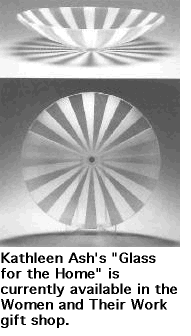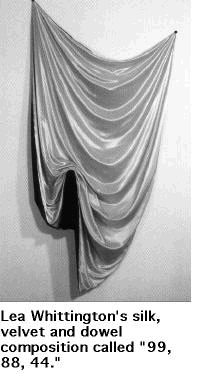|
Gallery's Grant to Fund Educational Services |
 |
|
by Jamie Reed
The Center for Women and Their Work recently celebrated its 21st birthday. Perhaps the best birthday gift came from the National Endowment for the Arts (NEA) in the form of a $35,000 grant. The one-year renewable grant will be used to fund educational services aimed at the children of Austin and the visiting public.
With the money, Women and Their Work can afford to commission curators from other galleries to describe the featured artist's work in short write-ups that go into brochures. The glossy brochures display some of the artist's work, in color, and are designed to educate gallery visitors on the artist.
The grant will also help fund a gallery website. Currently, the only way to access Women and Their Work online is through austin360.com. The upcoming site will have an independent address in cyberspace.
Latina playwright Ruby Nelda Perez put on a bilingual, one-person play for children at the target schools. Perez had no script for her performance and judged her audience's reactions to decide how much Spanish or English to incorporate. After the school workshops, Perez performed for a sold-out audience at the Dougherty Arts Center, where a Pierce Middle School teacher brought eight of her students. "After Perez finished the kids came up and asked if she would sign their programs -- as if she were a celebrity. One boy told her he was going to learn Spanish after watching her play," Cowden said.
Women and Their Work has introduced over 18,000 school children to art and artists in the past twelve years. Hopefully, the NEA grant will enable the organization to reach even more children (and adults) in the coming years.
Since Women and Their Work is a nonprofit organization, funding is always needed. Although the gallery's finances are currently running smoothly, there have been problem years. In 1986, when Texas went into a deep economic recession, Women and Their Work hit a wall on funding. All government, city and state funding crashed while donations from private sources decreased. "It took us three to four years to get back on track and moving ahead," Cowden said. Once back on track, galleries will, like all businesses, attempt to stay in the black, however they can.
Nonprofits depend heavily on donations and grants. Cowden admits it can get tempting to chase the grants, choosing artists that will allow for the most monetary benefit. For example, Women and Their Work receives a grant from the Andy Warhol Foundation that is only good toward printmaking. If a gallery goes after too many of these grants, they may lose their edge by sacrificing cutting-edge controversial works for the conservative funded works. "It is always challenging to an art institute to avoid chasing money -- especially in this time when controversy can get so overblown," Cowden said.
In order to keep grants, Women and Their Work avoids using donations or grants to fund artists whose work could be considered obscene. "When we have anything that might be controversial, we don't put corporate money into it. I understand that corporations give us money because they want to do something good for the community; they don't want to feel like they are funding pornography," Cowden said.
Although donations account for most nonprofit funding, Women and Their Work can still afford to feature more controversial artists by selling tickets to performances and making money via the gift shop. Although Cowden does not want to offend any of the benefactors, she said she would not choose money over a valued artist. Instead, Women and Their Work has found a delicate balance. Gallery employees happily take federal funds and every once in a while, such as last summer's Identity showcase, they put on a controversial exhibit.
"The Mapplethorpe trial, in a way, shows the true power of art," Cowden said. "Everyone thought the conservatives would win the trial, but here are twelve very ordinary people who realize that art is not pornography. They can see the difference."
And perhaps that is all we wish for of Women and Their Work -- to see the difference, continue to push boundaries and stay cutting edge.
|
||
top | this issue | ADA home |
||
 Executive Director Chris Cowden believes reaching out to the community via websites and brochures will not only educate, but will keep people coming back to the gallery. "Children are not the only ones that can benefit from art education. Sometimes adults will come in and ask, 'Where's the art?' when they are standing in the middle of it. Everyone can stand to learn more."
Executive Director Chris Cowden believes reaching out to the community via websites and brochures will not only educate, but will keep people coming back to the gallery. "Children are not the only ones that can benefit from art education. Sometimes adults will come in and ask, 'Where's the art?' when they are standing in the middle of it. Everyone can stand to learn more."
 The high-profile Robert Mapplethorpe trial accounts for many of today's curators who are wary of displaying controversial works. Local police raided the 1989 Cincinnati exhibit of Mapplethorpe's homoerotic photographs and brought obscenity charges against its curator for exhibiting the photographs. Although the conservatives believed they had an easy victory in court, the jury surprised them when they acquitted the curator on all counts. However, 1990 legislation stated art which met the legal definition of "obscene" could no longer receive federal funding.
The high-profile Robert Mapplethorpe trial accounts for many of today's curators who are wary of displaying controversial works. Local police raided the 1989 Cincinnati exhibit of Mapplethorpe's homoerotic photographs and brought obscenity charges against its curator for exhibiting the photographs. Although the conservatives believed they had an easy victory in court, the jury surprised them when they acquitted the curator on all counts. However, 1990 legislation stated art which met the legal definition of "obscene" could no longer receive federal funding.